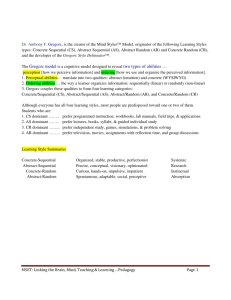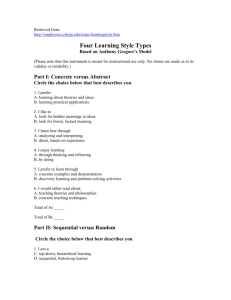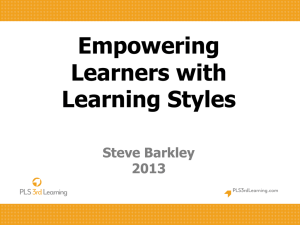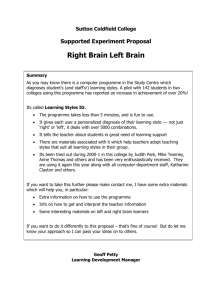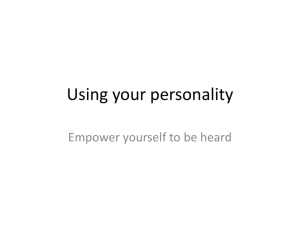Thinking Styles Test: Discover Your Preferred Learning Approach
advertisement
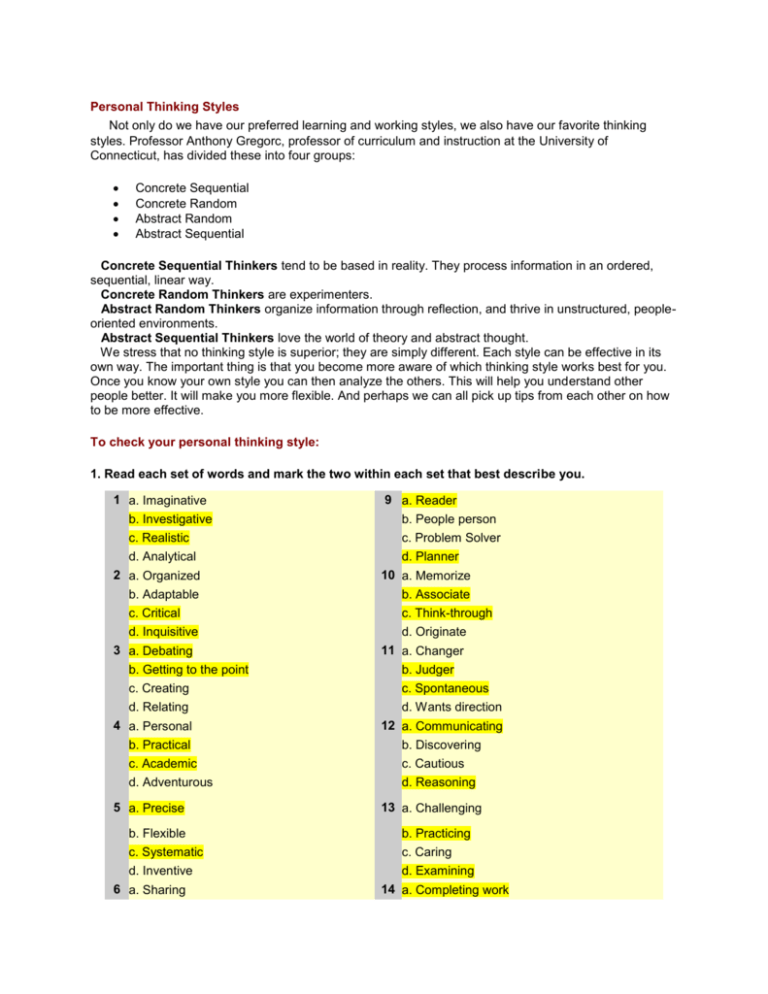
Personal Thinking Styles Not only do we have our preferred learning and working styles, we also have our favorite thinking styles. Professor Anthony Gregorc, professor of curriculum and instruction at the University of Connecticut, has divided these into four groups: Concrete Sequential Concrete Random Abstract Random Abstract Sequential Concrete Sequential Thinkers tend to be based in reality. They process information in an ordered, sequential, linear way. Concrete Random Thinkers are experimenters. Abstract Random Thinkers organize information through reflection, and thrive in unstructured, peopleoriented environments. Abstract Sequential Thinkers love the world of theory and abstract thought. We stress that no thinking style is superior; they are simply different. Each style can be effective in its own way. The important thing is that you become more aware of which thinking style works best for you. Once you know your own style you can then analyze the others. This will help you understand other people better. It will make you more flexible. And perhaps we can all pick up tips from each other on how to be more effective. To check your personal thinking style: 1. Read each set of words and mark the two within each set that best describe you. 1 a. Imaginative 9 a. Reader b. Investigative b. People person c. Realistic c. Problem Solver d. Analytical d. Planner 2 a. Organized 10 a. Memorize b. Adaptable b. Associate c. Critical c. Think-through d. Inquisitive d. Originate 3 a. Debating 11 a. Changer b. Getting to the point b. Judger c. Creating c. Spontaneous d. Relating d. Wants direction 4 a. Personal 12 a. Communicating b. Practical b. Discovering c. Academic c. Cautious d. Adventurous d. Reasoning 5 a. Precise 13 a. Challenging b. Flexible b. Practicing c. Systematic c. Caring d. Inventive d. Examining 6 a. Sharing 14 a. Completing work b. Orderly b. Seeing possibilities c. Sensible c. Gaining ideas d. Independent 7 a. Competitive d. Interpreting 15 a. Doing b. Perfectionist b. Feeling c. Cooperative c. Thinking d. Logical 8 a. Intellectual d. Experimenting b. Sensitive c. Hardworking d. Risk-taking 2. After completing the test above: In the columns below, circle the letters of the words you chose for each number. Add your totals for columns I, II, III, and IV. Multiply the total of each column by 4. The box with the highest number describes how you most often process information I II 1. C D 2. A C 3. B A 4. B C 5. A C 6. B C 7. B D 8. C A 9. D A 10. A C 11. D B 12. C D 13. B D 14. A C 15. A C Total ____ ____ III A B D A B A C B B B C A C D B ____ IV B D C D D D A D C D A B A B D ____ I _10__ x 4 = 40 Concrete Sequential (CS) II _14__ x 4 = 56 Abstract Sequential (AS) III _3__ x 4 = 12 Abstract Random (AR) IV _3__ x 4 = 12 Concrete Random (CR) 3. Graph your results. To graph your preferred thinking style, just place a dot on the number that corresponds to your score in each of the classifications and link the dots shown in the miniature diagram. Our thanks to John LeTellier and Dell Publishing, 666 Fifth Avenue, New York, NY 10103, for permission to reprint this test from Quantum Learning, by Bobbi DePorter. The test is based on research by Professor Anthony Gregorc. Top
